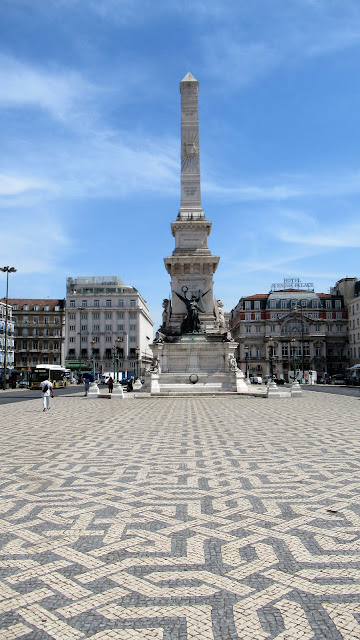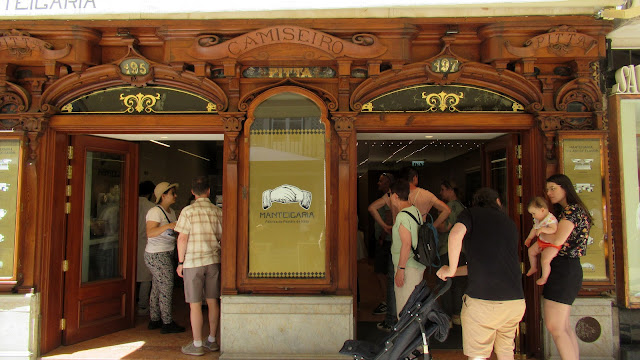We spent a wonderful ten days in Lisbon in May. The weather was kind to us: 30oC-31oC for the first half of our stay, and the middle 20s for the rest. Surprisingly, we did not find the 30 temperatures too hot, but nicely comfortable. Lisbon is a beautiful city and very vibrant: people seem to enjoy themselves a lot, and the parks - oh! the parks, they're just wonderful - are full of kiosks selling food with tables and benches provided for people to sit and enjoy their food. People seem to take advantage of this so you really get the sense of joie de vivre.
Our hotel was in the Baixa district which is very central so it was easy getting about. We were on Rua da Prata just off Praca de Fuguera
Near our hotel was this shop that sold canned sardines. You can find these all over Lisbon.
But, it's not just sardines that come in a can: there's also mackerel, octopus and codfish.
There are some beautiful buildings in Lisbon. What they tend to do is gut old buildings and just keep the front so that the identity of the city can be preserved - the interiors are then modernised.
Rua da Prata is next to Rossio square (Praca dom Pedro IV) which has been the city's main square since Medieval times and it remains the hub of commercial Lisbon. During the 19th century Rossio's plethora of cafes attracted Lisbon's painters and writers, though many of the artists' haunts were converted into banks in the 1970s.
There is only one cafe remaining now, cafe Nicola, one of the few surviving Art Nouveau cafes, once the haunt of some of Lisbon's great literary figures. We spent quite a few early evenings here, as the outdoor tables overlooking the bustle of Rossio were an excellent way to have a glass of wine. Unfortunately, much of the period interior has been sacrificed in the name of modernisation.
The central space of the square sparkles with mosaic-cobbled pavements. These are everywhere in Lisbon, on the pavements and in the squares, transforming otherwise mundane floor-space into masterpieces. They are black and white mosaics, with designs that vary from street to street, and block to block. Kown as Calcada Portuguesa, or Portuguese Pavement, these mosaics are a signature style that can be found wherever the Portuguese settled, from Macau to and Malacca in Asia to Rio de Janeiro in Brazil. But it is in Lisbon where they are so ubiquitous they simply become part of the streetscape.
Technically the designs are made of paving stones, not tiles. Chunky cubes of sturdy basalt and limestone form the mosaic squares, study enough for thousands of feet and durable enough to last centuries.
In the middle of the square a statue of Dom Pedro IV stands proud
We were lucky to have visited at this time of year.
They are even to be found in the metro station at Rossio

Broad Rua Augusta, completely paved in mosaics, runs from Rossio all the way down to Praca de Commercio and is the Baixa's main pedestrianised thoroughfare.
Filled with shops, market stalls
and touristy restaurants with the tables set in the middle of this pedestrianised street,
it can get pretty packed but its buskers and performers are always entertaining.
We loved the name of this fish bar.

The tiles that cover the whole of the facades of this two buildings are fairly plain in comparison to some others we have seen.
At the end of Rua Augusta is a huge arch, Arco da Rua Augusta. Adorned with statues of historical figures, it acts as a gateway to the city. The arch was built to celebrate Lisbon's reconstruction after the earthquake that devastated the city in 1755. Felt as far away as Jamaica, the earthquake struck Lisbon at 9:30 when most of the population was at Mass. Within the space of ten minutes there had been three major tremors and the candles of a hundred church altars had started fires that raged throughout the capital. A vast tidal wave later swept the waterfront and, in all 40,000 of the 270,000 population died. It was a disaster that ended Lisbon's golden age when Lisbon had been of the most active and important ports in Europe.
Some of the shop fronts here are stunning
Placa do Comercio was designed by the Marques de Pombal, the king's minister who redesigned the centre of the city following the earthquake. Its classical buildings were once a royal palace and the square is centred on an exuberant bronze equistrian statue of Dom Jose, monarch during the earthquake and the period of the capital's rebuilding.
The square has been pedestrianised in recent years in a successful attempt to make it more tourist-friendly with a panoply of cafes and shops on either side.
On one side of the square, under the arches
is the Bacalhau Museum. Cod is the national food in Portugal and you can find it everywhere, cooked beautifully.
It is the square's riverfront that is most appealing, however. High tide when I took this photograph.

A few bathers swam in the river or sunbathed on the sand.
From here, you can see the Christo Rei statue in the distance, standing with its outstretched arms above Almada. Inspired by Rio's Cristo Redentor statue, it was built in 1959 as a pilgrimage site to grace Portugal's non-participation in WWII.
To the left of the square stands this Art Deco building which is a booking office for various tours of the city.
the tiles are gorgeous
Just off Rua de Commercio stands the Praca do Municio
which houses the 19th century Neoclassical Camara Municipal (City Hall), where the Portuguese Republic was declared in 1910.
To the North of Rossio stands the elongated Placa cos Resturandores (Square of the Restorers) which takes its name from the renewal of independence from Spain in 1640.
The superb Art Deco frontage of the old Eden cinema is situated here - now it's an apartment-hotel.

I didn't manage to find out anything about this building which is a railway station now.




























































No comments:
Post a Comment